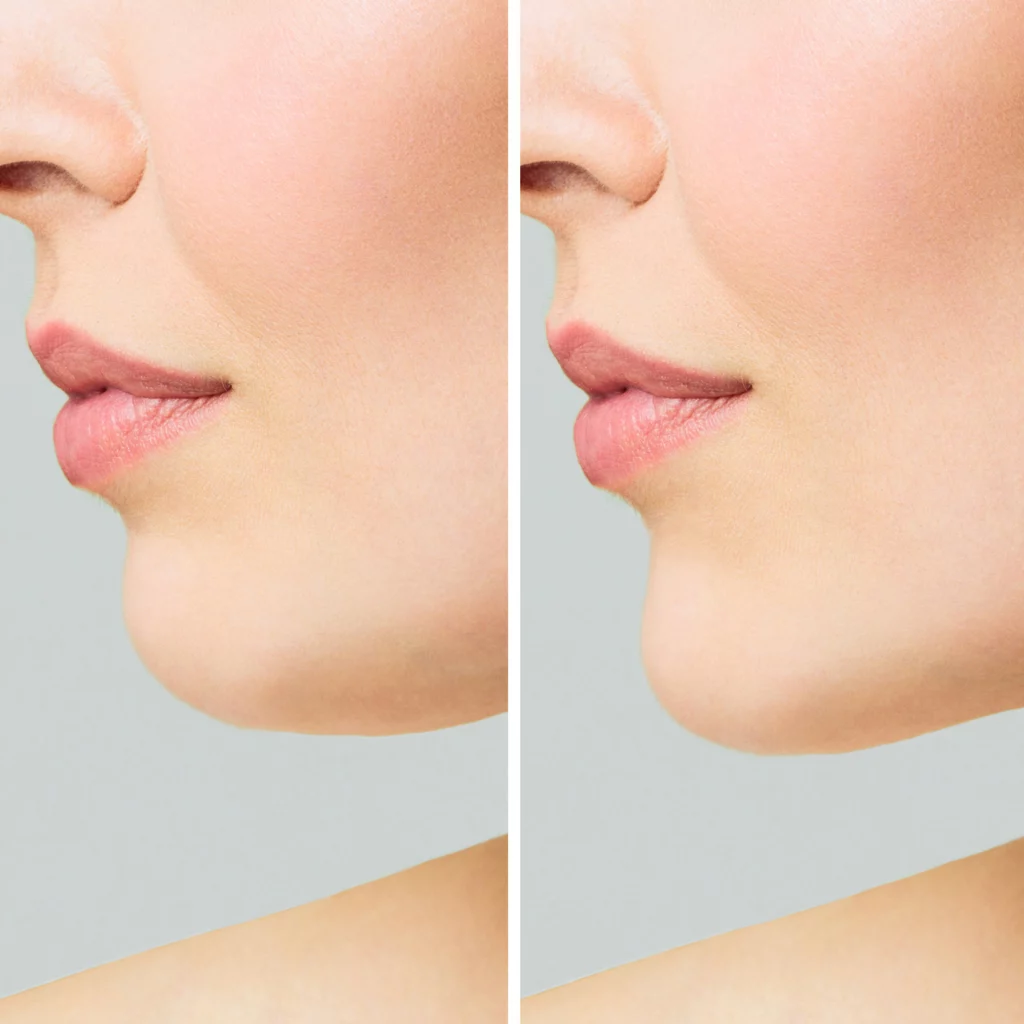How to Fix a Weak Chin?

Fixing a weak chin can be approached through both surgical and non-surgical methods, depending on the severity of the issue and personal preferences. One common surgical option is genioplasty, which involves repositioning the chin bone to enhance its projection and balance facial proportions. This procedure is often performed by a skilled plastic surgeon and can result in significant improvements to the appearance of the chin and jawline. It’s important to consult with a qualified medical professional to determine whether genioplasty is a suitable option and to understand the potential risks and benefits.
For those who prefer non-surgical alternatives, dermal fillers can offer a temporary solution to enhance chin projection. Injectable fillers, such as hyaluronic acid-based products, can be strategically placed along the chin to create the illusion of a more defined and prominent chin. While this option doesn’t involve surgery, the results are temporary and will require ongoing maintenance treatments to sustain the desired effect.
Additionally, facial exercises and makeup techniques can be utilized to create the illusion of a stronger chin. Certain facial exercises may help tone the muscles in the chin and jaw area, subtly improving its appearance over time. Skillful makeup application, like contouring and highlighting, can also provide a temporary enhancement by creating shadows and highlights to give the illusion of a more defined chin and jawline. Keep in mind that these non-surgical methods might not yield the same level of results as surgical interventions but can still offer noticeable improvements for those who prefer non-invasive options. As always, consulting with a medical professional is crucial to determine the most suitable approach based on individual circumstances and goals.
Understanding the Issue: What Causes a Weak Chin?

A weak chin, medically referred to as retrogenia or microgenia, is primarily caused by genetics and the way one’s facial bones develop. The chin’s prominence and definition are influenced by the position and size of the mandible bone, which forms the lower jaw. If the mandible is set back or underdeveloped, it can lead to a less defined chin and an imbalanced facial profile. This genetic predisposition to a weak chin can be inherited from parents or occur due to a combination of genetic factors that affect facial bone growth.
Another contributing factor to a weak chin can be an imbalance between the upper and lower jaw growth during development. Conditions like malocclusion (misalignment of the teeth and jaws) can lead to a less prominent chin appearance. Additionally, certain medical conditions or syndromes that affect bone development, such as congenital craniofacial anomalies, may result in a weak chin as well.
It’s important to recognize that a weak chin is a natural variation in facial anatomy and is not necessarily an indication of health problems. However, for those who are bothered by their weak chin and its impact on overall facial aesthetics, there are various surgical and non-surgical options available to address the issue and achieve a more harmonious facial balance. Consulting with a medical professional can provide a clearer understanding of the underlying causes and potential solutions for individuals seeking to enhance their chin’s appearance.
Assessment and Consultation: Evaluating Your Chin Profile
Assessing and evaluating your chin profile is a crucial step before deciding on any corrective measures. Consulting with a qualified plastic surgeon or dermatologist who specializes in facial aesthetics is essential to receive an accurate evaluation. During the consultation, the healthcare professional will carefully analyze your facial structure, focusing on the relationship between your chin, jawline, and other facial features.
The assessment will involve a thorough examination of both the frontal and side views of your face. The surgeon will consider factors such as the degree of chin projection, chin width, and the overall balance of your facial features. They will also take into account your unique bone structure, skin elasticity, and any asymmetries that may be present. It’s important to communicate your goals and concerns openly during the consultation, as this will help the healthcare provider recommend the most appropriate treatment options based on your desired outcome and personal preferences.
During the evaluation process, the healthcare professional may use imaging technology or computer simulations to visually illustrate the potential outcomes of different interventions. This can give you a better understanding of how various procedures might affect your overall facial appearance. Ultimately, the assessment and consultation phase is an opportunity to gather information, clarify expectations, and make an informed decision about the best approach to enhance your chin profile and achieve the desired aesthetic results.
Non-Surgical Options: Enhancing Your Chin without Surgery

Non-surgical options for enhancing the chin offer temporary solutions that can improve chin projection and facial balance without the need for surgery. One popular method involves the use of dermal fillers, which are injectable substances typically made from hyaluronic acid. These fillers can be strategically placed along the chin to add volume and projection, creating a more defined and balanced appearance. The procedure is minimally invasive, with minimal downtime, and the results can last anywhere from several months to a year or more, depending on the specific filler used.
Another non-surgical approach is through the use of neuromodulators like Botox. While Botox is commonly associated with wrinkle reduction, it can also be utilized to improve the appearance of a weak chin by relaxing the muscles responsible for pulling down the chin and creating a smoother jawline. This can help subtly enhance the chin’s projection without the need for surgery.
It’s important to note that non-surgical options are generally less invasive and come with fewer risks and downtime compared to surgical procedures. However, their effects are temporary and may require maintenance treatments to sustain the desired outcome. Consulting with a skilled medical professional is essential to determine the most appropriate non-surgical approach based on your individual anatomy, goals, and preferences. They can guide you through the available options and help you make an informed decision about the best course of action for enhancing your chin without undergoing surgery.
The Surgical Solution: How Chin Augmentation Works
Chin augmentation, a surgical solution to enhance a weak chin, typically involves a procedure called genioplasty. This surgical technique aims to improve the projection and contour of the chin by repositioning or altering the underlying bone structure. Genioplasty can be performed using different approaches, depending on the desired outcome and the surgeon’s expertise.
During the procedure, an incision is made either inside the mouth (intraoral approach) or under the chin (submental approach). Through this incision, the surgeon can access the chin bone (mandible) and make precise adjustments. In cases where the chin needs to be advanced, the surgeon may cut and reposition a segment of the chin bone, securing it in a more forward position. Alternatively, implants made from various materials, such as silicone or porous polyethylene, can be used to augment the chin’s projection.
The surgical solution of chin augmentation provides more permanent and transformative results compared to non-surgical options. It can effectively address moderate to severe cases of weak chin and create a more balanced facial profile. Recovery time varies, but patients can generally expect some swelling, bruising, and discomfort in the immediate postoperative period. Close adherence to post-operative care instructions and follow-up appointments with the surgeon is crucial to ensure proper healing and optimal outcomes.
A comprehensive consultation with a skilled and experienced plastic surgeon is essential to determine if chin augmentation is the right option for you. The surgeon will evaluate your facial structure, discuss your goals, and recommend the most suitable approach based on your individual circumstances. This personalized approach ensures that the surgical solution aligns with your desired aesthetic outcomes while considering factors such as facial harmony and long-term satisfaction.
Implants vs. Fillers: Choosing the Right Approach for You
Choosing between implants and fillers for chin augmentation depends on several factors, including your goals, preferences, anatomy, and desired longevity of results.
Implants offer a surgical and more permanent solution to enhance the chin’s projection. They come in various shapes and sizes to match individual facial proportions, and the material used is typically biocompatible. The surgery involves creating an incision, either inside the mouth or under the chin, to place the implant on the chin bone. Implants provide a lasting improvement to the chin’s appearance, but they do involve surgery, with associated risks, recovery time, and potential for scarring.
On the other hand, fillers provide a non-surgical option for enhancing the chin’s projection. Dermal fillers are injected into the chin area to add volume and definition. While the results are temporary, lasting several months to over a year, fillers offer a less invasive approach with minimal downtime. They can be a suitable option for those who want to experiment with a chin enhancement before committing to a more permanent solution or for those who prefer to avoid surgery altogether.
The choice between implants and fillers ultimately depends on your individual circumstances and preferences. If you’re seeking a long-lasting and transformative result, and you’re comfortable with the surgical process, implants may be the better choice. On the other hand, if you’re looking for a more subtle enhancement with minimal downtime, fillers might be the preferred option. Consulting with a board-certified plastic surgeon or dermatologist who specializes in facial aesthetics is crucial to receive personalized guidance and make an informed decision that aligns with your goals and concerns.
Preparing for Surgery: Steps to Take Before Chin Augmentation

Preparing for chin augmentation surgery involves several important steps to ensure a smooth and successful procedure. First and foremost, it’s crucial to choose a skilled and board-certified plastic surgeon with experience in facial procedures, including chin augmentation. Research potential surgeons, read reviews, and schedule consultations to discuss your goals and concerns.
During the pre-operative consultation, your surgeon will evaluate your facial anatomy, discuss your desired outcomes, and explain the procedure in detail. They will provide instructions for preparing for the surgery, which may include refraining from smoking and avoiding certain medications and supplements that could increase the risk of bleeding.
In the weeks leading up to the surgery, you should maintain a healthy lifestyle by eating well, staying hydrated, and getting sufficient rest. Follow any pre-operative instructions provided by your surgeon, which may involve fasting before the procedure and arranging for transportation to and from the surgical facility.
Plan for your post-operative recovery by creating a comfortable and organized space at home, preparing soft foods that are easy to consume during the initial healing period, and arranging for any necessary help or support from friends or family. Adhering to these steps and guidelines will contribute to a successful chin augmentation experience and promote a smoother recovery process.
The Procedure: What Happens During Chin Augmentation Surgery
Chin augmentation surgery, often performed through genioplasty, involves several key steps to enhance the projection and appearance of the chin. The procedure is typically performed under general anesthesia or intravenous sedation, ensuring your comfort throughout the surgery.
Once you’re under anesthesia, the surgeon will make an incision either inside the mouth along the lower gumline (intraoral approach) or underneath the chin (submental approach). The choice of incision location depends on factors such as the desired changes and surgeon’s preference.
Through the incision, the surgeon gains access to the chin bone (mandible). Depending on the chosen approach, they will then proceed to reshape and reposition the bone or place an implant on the chin to achieve the desired projection and contour. If the bone is being repositioned, screws and plates may be used to secure it in its new position.
After the bone adjustments or implant placement, the incisions are carefully closed using sutures or other closure techniques. The surgical site is then dressed with sterile bandages, and you will be moved to a recovery area where medical staff will monitor your initial post-operative condition.
Chin augmentation surgery typically takes a few hours, and once the anesthesia wears off, you will gradually regain consciousness. It’s normal to experience some swelling, bruising, and discomfort in the days following the surgery. Following your surgeon’s post-operative care instructions, taking prescribed medications, and attending follow-up appointments are essential to ensure a smooth recovery and optimal results.
Recovery Essentials: Healing After Chin Augmentation
Recovery after chin augmentation is a critical phase that requires careful attention to post-operative instructions to ensure optimal healing and results. In the immediate days following the surgery, you can expect some degree of swelling, bruising, and discomfort around the surgical site. Your surgeon may provide pain medications and antibiotics to manage discomfort and prevent infection. Cold compresses can help reduce swelling and alleviate discomfort during the initial stages of recovery.
It’s important to keep your head elevated and avoid bending over to minimize swelling. Soft foods that don’t require extensive chewing are recommended in the first few days after surgery to avoid straining the jaw. Maintaining proper oral hygiene is crucial, especially if the incision was made inside the mouth.
You will likely have sutures that will need to be removed by your surgeon during a follow-up visit. It’s essential to attend all scheduled post-operative appointments to monitor your progress and address any concerns.
The recovery period varies among individuals, but most people can return to light activities within a week or two. However, strenuous exercise and more demanding physical activities should be avoided for a few weeks to allow for proper healing. Swelling will gradually subside over the course of several weeks to months, revealing the final results of your chin augmentation.
Follow your surgeon’s guidance regarding the use of scar-reducing ointments, sun protection, and any specific care recommendations to optimize the healing process and achieve the best outcome. Patience and adherence to post-operative care instructions are key to ensuring a smooth recovery and enjoying the enhanced chin profile you desire.
Risks and Considerations: Being Informed About Chin Augmentation

Before undergoing chin augmentation, it’s crucial to be well-informed about the potential risks and considerations associated with the procedure. Like any surgical intervention, chin augmentation comes with certain risks, even when performed by experienced surgeons. These risks may include infection, bleeding, adverse reactions to anesthesia, scarring, and poor wound healing. There’s also the possibility of asymmetry, where the chin may not heal or appear symmetrically due to individual variations in healing or surgical outcomes.
Nerve damage is another consideration. Depending on the surgical approach and techniques used, there’s a slight risk of temporary or, in rare cases, permanent damage to sensory or motor nerves in the chin area. This can lead to altered sensation or muscle weakness, although advancements in surgical techniques have minimized these risks.
It’s important to thoroughly discuss these potential risks and considerations with your surgeon during the pre-operative consultation. A skilled and experienced surgeon will provide you with realistic expectations, help you understand the potential outcomes, and work with you to make an informed decision. Sharing your medical history, current medications, and any pre-existing conditions is crucial to ensuring your safety during the procedure.
In addition to physical risks, consider the emotional and psychological aspects of the procedure. Have a clear understanding of your motivations for undergoing chin augmentation and ensure that your expectations align with the potential outcomes. While chin augmentation can enhance your facial appearance, it’s important to approach it with a balanced perspective and the understanding that surgery is a serious decision that should be made with careful consideration and proper guidance from medical professionals.












